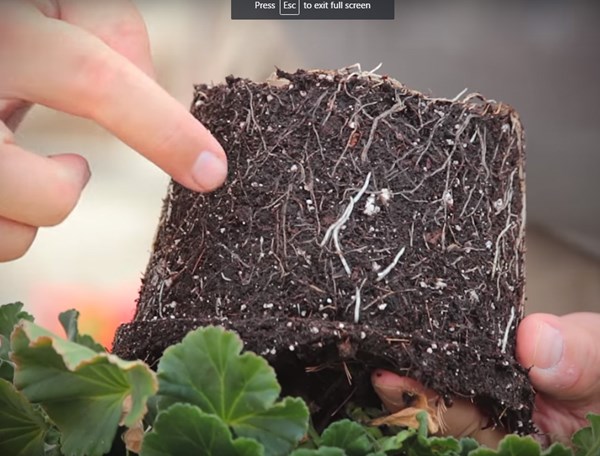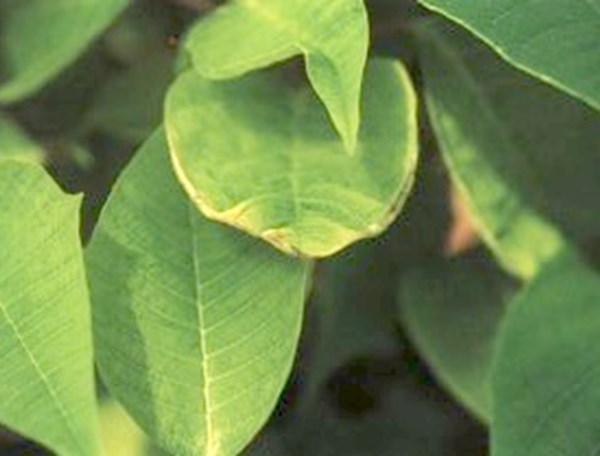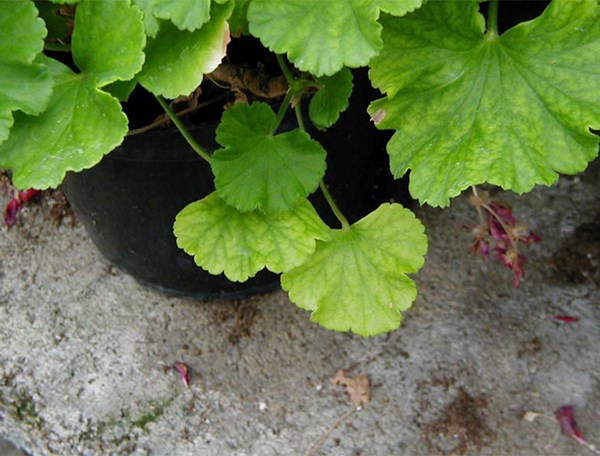Training Center
Growing Tough Crops: Vinca (Catharanthus roseus)
Thursday, September 7, 2023 | Ed Bloodnick
PDF version of this text: Growing Tough Crops: Vinca (Catharanthus roseus)
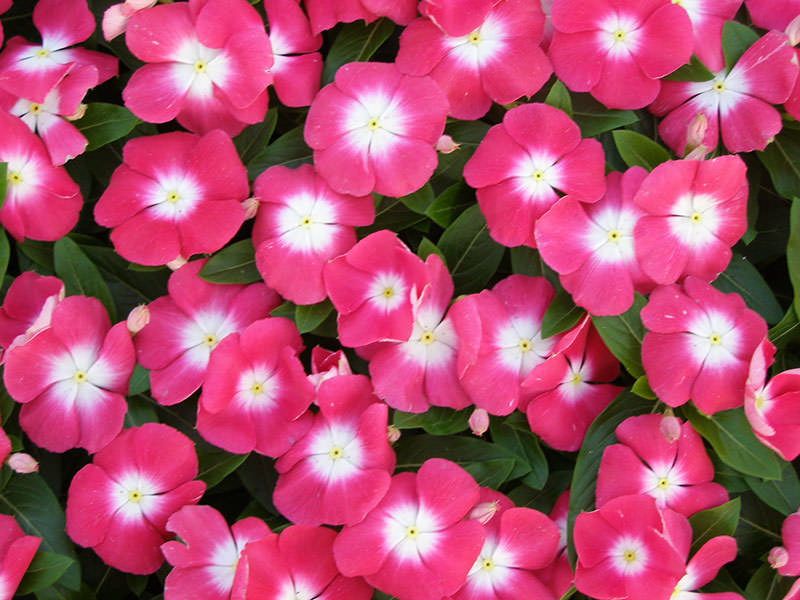
Vinca rosea
Vinca (Catharanthus roseus), commonly known as periwinkle, is an annual bedding plant which originated from Madagascar. It is a tough plant to grow because it requires higher air (up to 85˚F) and substrate (not less than 70˚F) temperatures than other annual plants, a low fertility, high porosity substrate, high relative humidity and high light.
Gardeners choose Vinca because it is relatively drought-tolerant and performs well in dry and hot locations exposed to full sun. Another important benefit of this annual plant is that it flowers during the entire summer. Vinca flowers come in a wide variety of colors such as red, dark red, white, pink, light pink, and purple.
Types of Vincas
In general, there are three types of Vincas: creeping (spreads 8-10 inches), dwarf (10-14 inches tall) and a border type (bigger flowers and 14-20 inches tall). In this article, the focus will be on the latter two types in which there are several series, which include: Jams N’ Jellies, Titan, Pacifica XP, Mediterranean, Cooler, Heat Wave, Blue Pearl, Tropicana, Passion, Cora, and others.
How To Grow Vinca From Seeds
Stage 1
Seeds have to be sown in a disease-free and fully saturated substrate; the seeds must be under dark conditions (i.e., covered with vermiculite) in order to germinate. When testing the substrate, the pH meter should indicate between 5.5 and 5.8, EC from 0.5 to 0.75 dS/m, temperature should be at 77˚F (±1˚F), and relative humidity at 100%. This stage lasts up to 7 days, and it ends when the radicles emerge.
Stage 2
This stage is characterized by stem and cotyledon emergence. Substrate pH should still be between 5.5 and 5.8, EC around 1 dS/m, and substrate temperature reduced to 76.5˚F (±1.5˚F). The substrate should be moist but not wet, and relative humidity dropped to 40%.
When the cotyledons have expanded, the plugs can be fertilized once a week at 50-75 ppm N with a low phosphorus fertilizer, such as 14-0-14, 17-5-17, or 21-5-20. Verify that the fertilizer used is compatible with your water. At this stage, it is recommended to apply fungicides to prevent Thielaviopsis and Rhizoctonia. This stage lasts from 7 to 10 days.
Stage 3
During this stage, which lasts from 15-24 days, the true leaves develop, roots reach the edge of the plug, and auxiliary (side) shoots start to develop. Substrate pH should be between 5.8 and 6.2, EC <1.5 dS/m, and substrate temperature should be maintained at 76.5˚F (±1.5˚F).
Substrate should still be moist but not dry, as this can lead to root damage and induce iron deficiency.
As mentioned before, proper watering is crucial; avoid watering in the late day or evening, as vincas could be vulnerable to airborne diseases. Assuming these fertilizers are compatible with the water quality, sources suggest alternating fertilizers such as 20-10-20 and 14-0-14, and application once per week at a rate of 100-150 ppm N.
At this stage, growth regulators can be used to control height, and a preventive fungicide application is recommended for Thielaviopsis, Pythium, Phytophthora and Rhizoctonia.
Stage 4
This final finishing stage lasts from 25-35 days. Substrate pH, EC, watering, and temperature remain the same as the previous stage. Sources suggest fertilization once a week with 14-0-14 at 100-150 ppm N (the goal is to minimize the application of ammonium and phosphorus).
Monitor substrate pH with a pH meter as it can quickly increase while using a potentially basic fertilizer. Growth regulators can be used for height control, and preventive fungicide applications are still recommended for Thielaviopsis, Pythium, Phytophthora and Rhizoctonia.
Caring For Vinca
If you do not grow your own vinca plugs and have them shipped in, it is necessary to do a visual inspection of the roots and leaves for pest and disease control. The roots should be white, fuzzy, and present all around the substrate.
Transplanting Vinca
Transplant plugs immediately to avoid stress. Vinca roots are fragile, therefore avoid over-handling the plugs. If the roots suffer damage, it is very difficult to get them to fully recover and they are more susceptible to diseases.
When transplanting, do not plant vinca plugs deep; the top of the plug should be level with the surface of the substrate. The pH of the substrate should be between 5.4-6.2, and EC from 1.25-1.5 dS/m. By maintaining the low end of the optimum pH range, iron uptake is more efficient, and it also helps suppress Thielaviopsis.
Temperature and Humidity
Annual vincas prefer to be grown in a very warm environment and this is why many growers have difficulty with them. Daytime temperatures should be around 82˚F (±2˚F), and at night, around 68˚F (±1˚F). Temperatures below 64˚F can stunt plant growth and cause leaves to turn yellow.
Moreover, temperatures under 60˚F for several days can delay flowering. Vinca growth and development is optimal in full sunshine.
After transplanting vinca plugs, it is necessary to thoroughly water in without any fertilizer. After a week, begin constant liquid fertilization at a rate of 100-150 ppm N.
Fertilizing Vinca
The fertilizer used depends on water quality and should have a nitrogen-potassium ratio of 1:1. Some sources suggest using 20-10-20 alternated with 15-0-15. If needed, add magnesium sulfate (Epsom salts) to your “potentially acidic” feed at a rate of 2-4 ounces / 100 gal, or once a month at a rate of 16 oz/ 100 gal. Avoid applying fertilizer with ammonium rates >25ppm, because it inhibits root growth, or phosphorus rates >20ppm, because it can cause stretching in plants.
Watering Vinca
Irrigate vincas in the morning so any water on the leaves can evaporate by evening. A good recipe for disease is watering when air circulation is low and later in the day, since the leaves cannot dry by evening.
Allow the growing medium to dry out between waterings (the surface of a peat-based substrate should turn light brown to tan before watering), since the lack of oxygen can stress roots and make them susceptible to root diseases. If plants look like they need water in the afternoon, it is better to wait and water them the next morning.
Plug size is important regarding crop growth and finishing; small plugs take more time to mature than larger plugs. This can be explained because the root system is smaller than in large plugs. It is difficult to get good quality plants if the seedlings are too small or too big. Small plugs (512’s and 384’s) are recommended for pack production, 288’s are recommended for pot production, and 72’s for hanging baskets.
Pest and Diseases of Vinca
Insects that commonly infest vincas are aphids, thrips, spider mites, and white flies. In order to have good pest control, use good scouting and maintain good sanitation by pulling weeds and quarantining new plants that come into the greenhouse.
Diseases can be avoided by utilizing clean trays and containers, using a high porosity substrate with a good drainage capacity, and by creating conditions that do not favor diseases such as: low humidity, warm substrate and air temperatures, dry leaf surfaces (especially into the evening), and allowing the substrate to dry out.
The most common diseases of vincas are black root rot (caused by Thielaviopsis, the most common root disease in vincas) and damping-off (caused by Rhizoctonia, Pythium and Phytophthora).
Vincas that are under stress from overwatering, high EC, cold temperatures, improper pH, etc. are most susceptible to attacks from these pathogens.
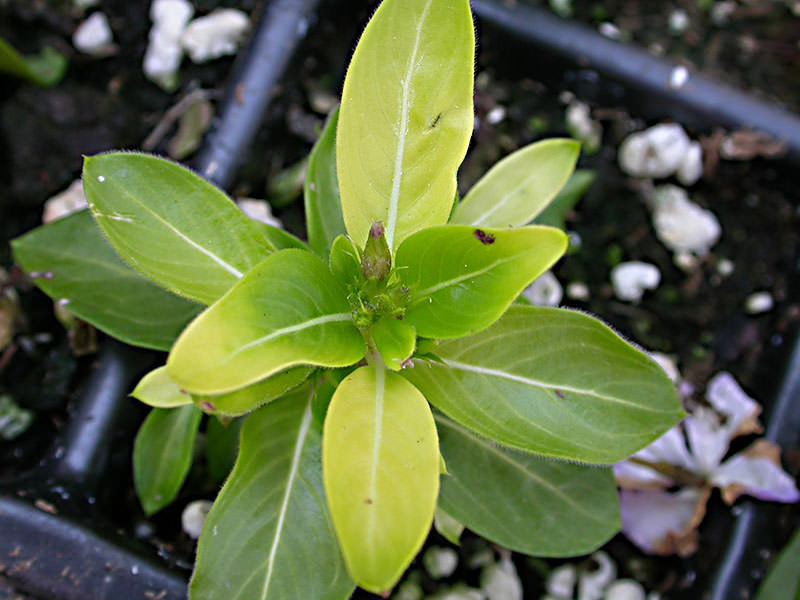
Vinca infested with Thielaviopsis
Thielaviopsis
Vincas appear stunted with interveinal chlorosis, similar to iron deficiency. The roots look black from the black spores that reside within them. Roots are more susceptible to black root rot if they are exposed to high EC, high pH (>5.5) and low temperatures.
Rhizoctonia
Vincas turn yellow and fall over or break at the base of the stem. The roots have brown lesions which obstruct water uptake; the leaves become yellow and the plant suddenly dies.
Pythium
Roots become tan to brown. It starts at the growing tip of the roots, and it progresses to the base of the roots. Vincas start to suffer because water uptake decreases and plants start to wilt, or in the worst-case scenario, they die. Pythium is a water mold that thrives in a saturated substrate. It easily attacks plants that are stressed from high EC and temperature extremes in the substrate.
Phytophthora
Symptoms appear to be similar to those of other root diseases; the roots become dark brown. Phytophthora is also a water mold that thrives in a wet substrate. It can also attack vincas above the soil line, and it appears as dark lesions on the stem causing the upper portion to wilt and die.Take-Home Message
Take-Home Message
Annual vincas like high temperatures, high relative humidity, high light, a non-saturated, porous substrate such as PRO-MIX HP BIOFUNGIDE + MYCORRHIZAE, and low initial fertilization. In addition, water early in the day to allow foliage to dry before evening, and allow the substrate to dry out between waterings. Monitor the substrate and avoid high pH and high EC.
For more information, contact your Premier Tech Grower Services Representative:
 |
 |
 |
 |
|---|---|---|---|
|
Ed Bloodnick |
Nathan Wallace-Springer |
Lance Lawson |
Victor Brantly |
 |
 |
 |
|
|
Troy Buechel |
Susan Parent |
Jose Chen Lopez |
* Note: The fertilization suggestions taken from sources and included herein are not necessarily endorsed by Premier Tech. Some may not work for your crop depending on the alkalinity and nutrients provided by your water. Please have your water tested and discuss the results with your fertilizer manufacturer to determine which fertilizer works best for vincas.
PRO-MIX® is a registered trademark of PREMIER HORTICULTURE Ltd.
Related Articles
-
How watering influences root disease in your crops
Premier Tech Horticulture Specialist Troy Buechel gives some advices about the relationship between watering and root disease.
-
Role of Calcium in Plant Culture
This article will help you better understand the role of calcium when cultivating plants.
-
Role of Magnesium in Plant Culture
Do your plants have a deficiency or a toxicity related to magnesium? This article will help you better control this secondary nutrient.

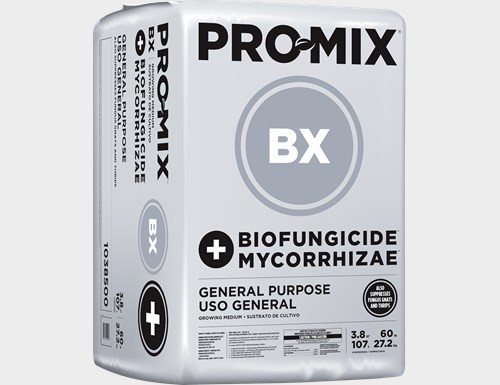
 Where to find our products
Where to find our products
